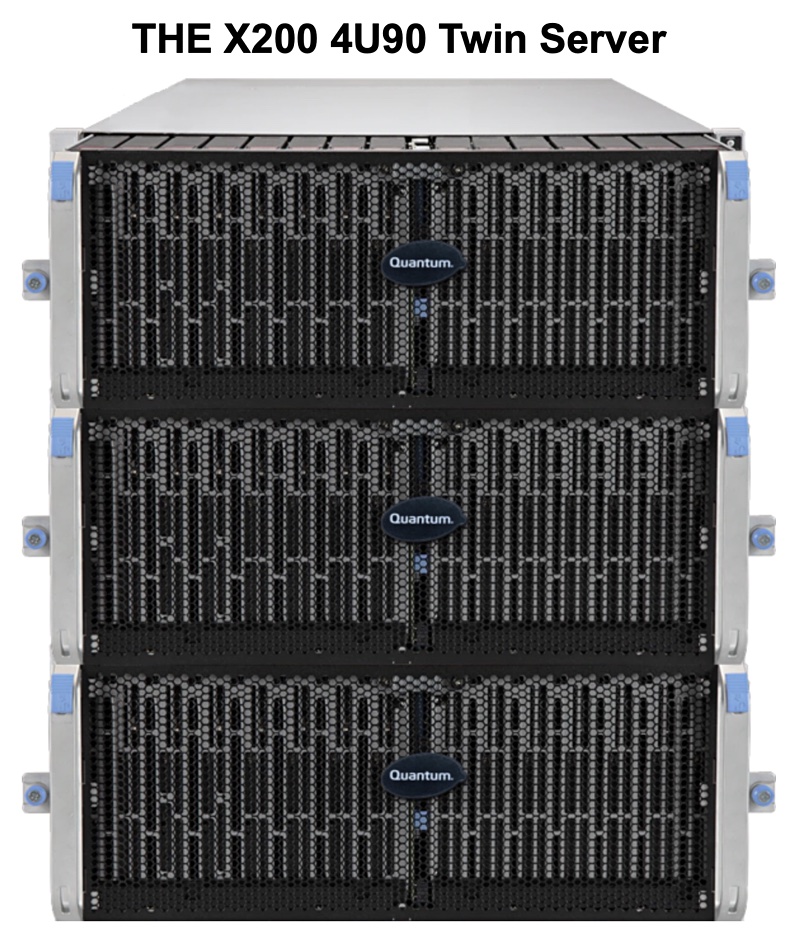Quantum has taken the ActiveScale object storage business it bought from Western Digital and given it a significant upgrade with new hardware and software.
Via the acquisition it obtained entry-level modular P100 and X100 rack-scale cabinets full of 14TB drives, and ActiveScale v5.5 software with NFS file and S3 object performance balancing using an Amplidata software base. The X100 supported 8.2PB per rack and could scale to 45 billion objects.
The intent is to develop an everlasting archive system with massive capacity. Quantum execs told an IT Press Tour virtual briefing that it was already shipping its new ActiveScale X200 platform with v6 ActiveScale software. It claims the X200 has 78 per cent more capacity, 7x performance, and a 6x object count increase per rack – a total of 270 billion – compared to the X100.
Architecturally, ActiveScale 5 and the X100 had separate access nodes and data storage chassis, allowing for separate scaling but entailing configuration complexity. Now the two software control planes run on the same server/storage system base.
X200 hardware
A datasheet says the X200 comes in a 12 rack system with up to 4.86PB base capacity, and a box shot on Quantum’s website shows a 3-unit enclosure labelled “X200 4U90 Twin Server.” In other words the 12U chassis is composed of a 3 x 90-bay 4U sub-chassis. A quick bit of math shows that 270 x 18TB disk drives are being used to reach the 4.86PB base raw capacity.

Three of these 12U boxes can fit into a standard rack, implying a per-rack capacity of 14.6PB, exactly 78 per cent more than the X100 as Quantum says.
We asked if shingled media was being used, and Bruno Hald, Quantum’s Secondary Storage GM, said it was not.
Note that Supermicro’s 90-bay top-loading storage server looks exactly the same as a 4U X100 component chassis from the front, minus its Supermicro logo, of course.

We surmise Quantum is using these Supermicro components in the X200. They support 90 SAS or SATA drives with up to six slots for NVMe SSDs, and up to two third-gen Intel Xeon Scalable Processors for controllers.
Quantum doesn’t provide numbers for the maximum scaled-out X200 capacity nor the total number of objects supported; both are said to be effectively unlimited.
We asked if Quantum was looking to use SSDs as a fast access capacity object storage medium. Hald said: “We are looking at SSD object storage as a possibility [but] we are not being pushed in that direction by our customers.”
ActiveScale currently uses flash storage for its access layer data (metadata) and disk storage as the data layer repository.
ActiveScale 6 software
The v6.0 software has up to 19 nines of data durability. Quantum is positioning ActiveScale as an everlasting archive system and these durability numbers are appropriate for that role.
Objects are chunked, and data can be dispersed across three geographic locations and use Quantum’s dynamic data placement (DDP), a form of erasure coding. There is ongoing background object monitoring and repair. All this provides continuous data availability and operations even with a full data centre outage.
The software provides immutability with object locking and sustained performance with large or small files and objects, or a mix of these.
The v6 ActiveScale software is sold with a capacity-based subscription license.
We understand that Quantum’s acquired CatDV tagging software will be integrated with ActiveScale, and also that CatDV tag information could be used to generate object metadata.
Check out the ActiveScale datasheet to find out more.








